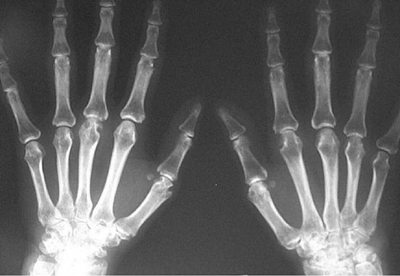Evaluation of Patients with Rheumatic Diseases
Carlos A. Estrada
Gustavo R. Heudebert
Approach to the Patient with Articular Complaints
Clinical Presentation
The clinical presentation of rheumatic diseases is framed on the unique patient’s background including age, gender, ethnicity, associated conditions, family history, and habits. Such characteristics can provide useful clues for patients presenting with signs or symptoms consistent with a rheumatic disease. We will consider these characteristics separately, consider mostly adult patients, organize on the basis of etiologic causes, and provide examples. We recognize that typical patterns occur in a few instances; however, we present a framework to efficiently recognize disease patterns. Table 1.1 summarizes the patient’s background and common clinical entities.
 |
A 24-year-old female comes to the Emergency Department with a 3-day history of pain in the right knee that resolved in 48 hours, followed by pain in her left wrist (migratory arthritis). She has also noticed difficulty holding to flatware on her right hand (tenosynovitis). She noticed onset of symptoms shortly after her menses (seen in disseminated gonococcal infection). Physical examination reveals pain with motion of the left wrist with a thickened synovium; flexion of digits is tender at the right hand (tenosynovitis), however, wrist flexion is not painful. There are a few pustules noted in the left forearm and right foot (arthritis–dermatitis syndrome).
Patient’s Background
Age
Crystal-induced arthropathies (gout and pseudogout) can present at any age; although, pseudogout usually presents in the fifth or sixth decade of life. Gout diagnosed in the twenties should raise the suspicion of lead exposure (saturnine gout), increased endogenous production of uric acid (e.g., lymphoproliferative disorder), or an inherent defect of production or excretion of uric acid.
Osteoarthritis (OA) usually presents in individuals older than 50 years of age. OA can be diagnosed in younger patients with past trauma (e.g., gymnasts) or in the familial form of the disease.
The infectious etiology of arthritis varies based on age. H. influenza arthritis presents almost exclusively in children, whereas gonococcal arthritis is diagnosed almost exclusively in sexually active individuals <40 years of age. Older patients are more likely to have comorbidities or underlying articular diseases such as OA or joint replacement. The affected joints are more vulnerable to synovial invasion, especially in the presence of bacteremia.
Determine the pattern of joint involvement:
Number of joints involved: monoarticular, oligoarticular, polyarticular (>3 joints)
Evolution of involvement: additive, migratory
Anatomic location: axial, peripheral
Symmetry: symmetric, asymmetric
Determine presence of inflammation:
Joints, tendon insertion, synovium
Determine pattern of muscle involvement:
Proximal versus distal
Painful versus painless
Careful neurological examination for patients with muscular complaints
Careful assessment of the skin, eyes, and mucous membranes
Ankylosing spondylitis, psoriatic arthritis, Reiter’s syndrome, and reactive arthritis (seronegative spondyloarthropathies) are more commonly seen in
young adults. Systemic sclerosis presents in the third and fourth decades of life. Systemic lupus erythematosus (SLE) mostly affects women during their reproductive years. Rheumatoid arthritis (RA) presents in the fourth and fifth decades of life.
young adults. Systemic sclerosis presents in the third and fourth decades of life. Systemic lupus erythematosus (SLE) mostly affects women during their reproductive years. Rheumatoid arthritis (RA) presents in the fourth and fifth decades of life.
Table 1.1 Patient’s Background and Diagnosis of Patients Presenting with Articular Complaints | ||||||||||||||||||||
|---|---|---|---|---|---|---|---|---|---|---|---|---|---|---|---|---|---|---|---|---|
| ||||||||||||||||||||
Systemic vasculitis exhibits a wide range of age distribution. For example, Henoch-Schönlein purpura is seen mostly in children (some present in their twenties), Takayasu’s arteritis presents in young females, giant cell arteritis mostly occurs in the elderly, and polymyalgia rheumatica is seldom seen in individuals <50 years of age.
Gender
The best known rheumatic diseases with female predilection are SLE and systemic sclerosis. Other conditions with female predominance include Takayasu’s arteritis, giant cell arteritis, Sjögren syndrome, and rheumatoid arthritis. However, the gender difference in RA is less prominent among older patients. Rheumatic conditions with male predominance include gout, Reiter’s syndrome, and ankylosing spondylitis. Most of the systemic vasculitides exhibit a small male preponderance.
Ethnicity
A clear ethnic predilection is seen in few rheumatic disorders. More common in whites are the HLA-B27-positive seronegative spondyloarthropathies (Reiter’s syndrome and ankylosing spondylitis), giant cell arteritis, and OA. Sarcoidosis is more common in young blacks, at least in the United States. For example, sarcoidosis should be considered in a young black patient presenting with ankle arthralgias. Takayasu’s arteritis tends to be present in women of Asian descent. Behçet’s disease is more common in the Mediterranean basin, especially among Turkish people. Familial Mediterranean fever is seen more commonly in individuals from the Middle East.
Patients with rheumatic conditions can present with a myriad of complaints. Symptoms can be localized and specific for a certain diagnosis; however, symptoms can be ill-defined and physical findings subtle on many occasions. Rheumatic diseases lend themselves well to a systematic approach of assessment and diagnosis. The patient’s background, as previously mentioned, can provide useful clues. The pattern of joint involvement, the presence of inflammation (see physical findings below), and signs and symptoms in other organs can also guide the differential diagnosis.
Symptomatology
Pattern of Joint Involvement
A summary of typical patterns of joint involvement and certain diagnosis is included in Table 1.2. The number of joints involved, evolution of joint involvement, anatomic location of joints, and symmetry are important features in the history and physical examination of patients with joint complaints.
Table 1.2 Pattern of Joint Involvement and Diagnosis
Stay updated, free articles. Join our Telegram channel
Full access? Get Clinical Tree
 Get Clinical Tree app for offline access
Get Clinical Tree app for offline access

|
|---|





